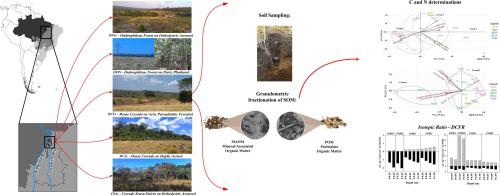亚马逊雨林转变为草原对区域和全球碳循环具有重大影响。受影响的有机库及其范围的描述对于准确预测森林向牧场的转变至关重要。我们评估了巴西亚马逊雨林过渡环境中森林向牧场转变后土壤有机质 (SOM)、颗粒有机质 (POM) 和矿物相关有机质 (MAOM) 颗粒部分的土壤碳和氮储量。塞拉多生物群落。在巴西托坎廷斯州隆特拉河流域选择了五个研究情景(SS)。这些情况是通过植被和土壤类别之间的关联来确定的:OFAr(Ombrophilous Forest on Orthodystric Arenosol);OFPt(伞生森林)彼得里克·普林索索尔);DCFr(Acric Petroplinthic Ferralsol上的密集塞拉多);DCAc(Haplic Acrisol上的密集塞拉多);和 CSAr(Cerrado Sensu Stricto on Orthodystric Arenosol)。在每个SS中,除了具有自然植被的参考区域外,还在不同种植时间(10至30年)的牧场区域采集了土壤样本。DCFrP30(30年牧场)和DCFrNV(自然植被区)在统计上相似,两者均具有最高的平均碳储量(0–20 厘米:41.5 ± 6.6 吨碳/公顷;0–40 厘米:64.6 ± 12.3 吨碳/公顷;0–60 厘米:85.0 ± 14.8 吨碳/公顷;0–100 cm: 102 ± 21.8 t C/ha) 和氮库 (0–20 cm: 3.5 ± 0.6 t C/ha; 0–40 cm: 5.3 ± 0.9 t C/ha; 0–60 cm: 6.9 ± 1.1 t C/ha) /ha;0–100 cm:8.1 ± 1.5 t C/ha),特别是在 MAOM。最高的 CC 3 (δ 13 C ≈ -27‰) 损失发生在较新的 OFAr 和 CSAr 牧场以及 DCFr 中,而 CC 4 (δ 13C ≈ -14‰)在 POM 和 OFPt 和 DCFr 的 20 年龄牧场中增益更大。我们的结果表明,森林转变为牧场后,SOM 颗粒部分中土壤 C 和 N 的储量和分布发生了显着变化。此外,研究结果为制定注重环境质量恢复和保护以及减缓气候变化的战略提供了重要的见解,特别是在亚马逊地区,塞拉多-亚马逊雨林过渡区近年来已被纳入农业用地。
 "点击查看英文标题和摘要"
"点击查看英文标题和摘要"
Soil carbon and nitrogen stocks following forest conversion to long-term pasture in Amazon rainforest-Cerrado transition environment
The conversion of Amazon rainforest to grasslands has significant implications for regional and global carbon cycling. The description of affected organic pools and their extent is crucial for accurate prediction of forest-to-pasture conversions. We assessed soil C and N stocks in granulometric fractions of soil organic matter (SOM), particulate organic matter (POM) and mineral-associated organic matter (MAOM), following forest-to-pasture conversion in transition environments of the Brazilian Amazon rainforest and Cerrado biomes. Five study situations (SS) were selected in the Lontra River basin, Tocantins state, Brazil. The situations were established by the association between vegetation and soil classes: OFAr (Ombrophilous Forest on Orthodystric Arenosol); OFPt (Ombrophilous Forest on Petric Plinthosol); DCFr (Dense Cerrado on Acric Petroplinthic Ferralsol); DCAc (Dense Cerrado on Haplic Acrisol); and CSAr (Cerrado Sensu Stricto on Orthodystric Arenosol). In each SS, soil samples were collected in pasture areas with different planting times (between 10 and 30 years), in addition to a reference area with natural vegetation. DCFrP30 (30-y-old pasture) and DCFrNV (natural vegetation area) were statistically similar, both having the highest mean C stocks (0–20 cm: 41.5 ± 6.6 t C/ha; 0–40 cm: 64.6 ± 12.3 t C/ha; 0–60 cm: 85.0 ± 14.8 t C/ha; 0–100 cm: 102 ± 21.8 t C/ha) and N stocks (0–20 cm: 3.5 ± 0.6 t C/ha; 0–40 cm: 5.3 ± 0.9 t C/ha; 0–60 cm: 6.9 ± 1.1 t C/ha; 0–100 cm: 8.1 ± 1.5 t C/ha), especially in MAOM. The highest C-C3 (δ13C ≈ −27‰) losses occurred in newer pastures of OFAr and CSAr and in DCFr, while C-C4 (δ13C ≈ −14‰) gains were greater in POM and in 20-y-old pastures of OFPt and DCFr. Our results demonstrate significant change in stocks and distribution of soil C and N in SOM granulometric fractions following the conversion of forest to pasture. Moreover, the results give important insight into the development of strategies focused on the recovery and conservation of environmental quality and mitigation of climate change, particularly for the Amazon region where Cerrado-Amazon rainforest transition areas have been incorporated into agricultural land in recent years.









































 京公网安备 11010802027423号
京公网安备 11010802027423号